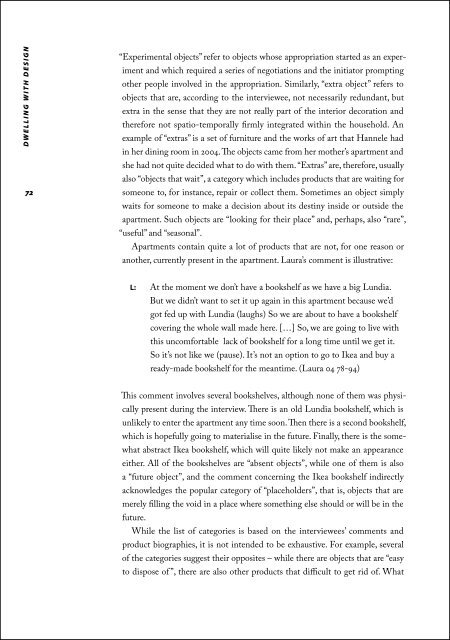Lataa ilmaiseksi
Lataa ilmaiseksi
Lataa ilmaiseksi
You also want an ePaper? Increase the reach of your titles
YUMPU automatically turns print PDFs into web optimized ePapers that Google loves.
D W E L L I N G W I T H D E S I G N<br />
72<br />
“Experimental objects” refer to objects whose appropriation started as an experiment<br />
and which required a series of negotiations and the initiator prompting<br />
other people involved in the appropriation. Similarly, “extra object” refers to<br />
objects that are, according to the interviewee, not necessarily redundant, but<br />
extra in the sense that they are not really part of the interior decoration and<br />
therefore not spatio-temporally firmly integrated within the household. An<br />
example of “extras” is a set of furniture and the works of art that Hannele had<br />
in her dining room in 2004. The objects came from her mother’s apartment and<br />
she had not quite decided what to do with them. “Extras” are, therefore, usually<br />
also “objects that wait”, a category which includes products that are waiting for<br />
someone to, for instance, repair or collect them. Sometimes an object simply<br />
waits for someone to make a decision about its destiny inside or outside the<br />
apartment. Such objects are “looking for their place” and, perhaps, also “rare”,<br />
“useful” and “seasonal”.<br />
Apartments contain quite a lot of products that are not, for one reason or<br />
another, currently present in the apartment. Laura’s comment is illustrative:<br />
L: At the moment we don’t have a bookshelf as we have a big Lundia.<br />
But we didn’t want to set it up again in this apartment because we’d<br />
got fed up with Lundia (laughs) So we are about to have a bookshelf<br />
covering the whole wall made here. […] So, we are going to live with<br />
this uncomfortable lack of bookshelf for a long time until we get it.<br />
So it’s not like we (pause). It’s not an option to go to Ikea and buy a<br />
ready-made bookshelf for the meantime. (Laura 04 78-94)<br />
This comment involves several bookshelves, although none of them was physically<br />
present during the interview. There is an old Lundia bookshelf, which is<br />
unlikely to enter the apartment any time soon. Then there is a second bookshelf,<br />
which is hopefully going to materialise in the future. Finally, there is the somewhat<br />
abstract Ikea bookshelf, which will quite likely not make an appearance<br />
either. All of the bookshelves are “absent objects”, while one of them is also<br />
a “future object”, and the comment concerning the Ikea bookshelf indirectly<br />
acknowledges the popular category of “placeholders”, that is, objects that are<br />
merely filling the void in a place where something else should or will be in the<br />
future.<br />
While the list of categories is based on the interviewees’ comments and<br />
product biographies, it is not intended to be exhaustive. For example, several<br />
of the categories suggest their opposites – while there are objects that are “easy<br />
to dispose of ”, there are also other products that difficult to get rid of. What
















